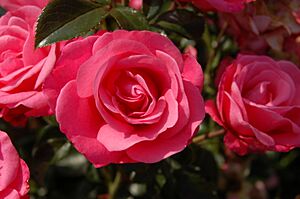Rose (disambiguation) facts for kids
A rose is a beautiful flowering plant known for its fragrant blooms and often thorny stems. It belongs to the Rosa genus, which is part of the Rosaceae family. Roses are one of the most popular flowers in the world, grown for their beauty, scent, and use in gardens and bouquets. They come in many different colors, shapes, and sizes, each with its own unique charm.
Contents
What is a Rose Plant?
Roses are woody perennial plants, meaning they live for more than two years and have stems that become hard and woody. Most rose plants have thorns, which are sharp growths on their stems that help protect them from animals. The flowers of a rose plant are often large and showy, with many petals arranged in layers. They are famous for their sweet and pleasant smell.
Types of Roses
There are thousands of different types of roses, created through centuries of breeding. They are generally grouped into three main categories:
- Wild Roses: These are the original roses found in nature. They usually have five petals and simple flowers.
- Old Garden Roses: These are types of roses that existed before 1867. They often have strong scents and a classic, romantic look. Examples include Alba roses and Damask roses.
- Modern Roses: These roses were developed after 1867 and are known for their continuous blooming and wide range of colors. Popular modern roses include:
* ==== Hybrid Tea Roses ==== These are the classic long-stemmed roses often seen in flower shops. They usually have one large flower per stem. * ==== Floribunda Roses ==== Floribundas produce clusters of flowers on each stem, making them great for adding lots of color to a garden. * ==== Climbing Roses ==== These roses have long, flexible stems that can be trained to grow up walls, trellises, or arches.
Where Do Roses Grow?
Roses are native to many parts of the world, including Asia, Europe, and North America. They have been grown and admired for thousands of years. Today, roses are cultivated in almost every country, from small home gardens to large commercial farms. They prefer sunny locations and well-drained soil to grow best.
History of Roses
Roses have a long and rich history. Ancient civilizations like the Romans, Greeks, and Chinese valued roses for their beauty, fragrance, and medicinal properties. They were used in perfumes, medicines, and even as decorations in feasts. Over time, people began to breed roses to create new varieties with different colors, sizes, and scents. This practice continues today, leading to the amazing diversity of roses we see.
How to Grow Roses
Growing roses can be a rewarding hobby. Here are some basic tips:
- Sunlight: Roses need at least six hours of direct sunlight each day to produce many flowers.
- Soil: They prefer rich, well-drained soil. Adding compost helps the soil stay healthy.
- Watering: Roses need regular watering, especially when they are young or during dry periods. It's best to water the base of the plant to keep the leaves dry.
- Pruning: Trimming rose bushes helps them grow stronger and produce more flowers. This is usually done in late winter or early spring.
Reproduction of Roses
Roses can reproduce in several ways:
- Seeds: After a rose flower is pollinated, it forms a fruit called a rose hip, which contains seeds. These seeds can be planted, but the new plant might not be exactly like the parent.
- Cuttings: A common way to grow new roses is by taking a piece of a stem (a cutting) from an existing plant and planting it. This creates a new plant that is identical to the parent.
- Grafting: Many modern roses are grown by grafting, where the upper part of one rose variety is joined to the root system of another. This combines the best features of both.
Life Cycle of a Rose
The life cycle of a rose plant begins as a seed or a cutting.
- Germination/Rooting: A seed sprouts, or a cutting develops roots, and a small plant begins to grow.
- Vegetative Growth: The plant grows stems, leaves, and develops a strong root system.
- Flowering: Once mature, the plant produces flower buds, which then open into beautiful roses. This is often the most admired stage.
- Pollination and Seed Production: If pollinated by insects or wind, the flowers develop rose hips containing seeds.
- Dormancy: In colder climates, roses enter a period of rest during winter, shedding leaves and preparing for new growth in spring.
- New Growth: In spring, the cycle begins again with new shoots and leaves.
Uses of Roses
Roses are used for much more than just decoration:
- Gardens and Landscaping: They are a popular choice for gardens, parks, and public spaces due to their beauty and fragrance.
- Cut Flowers: Roses are one of the most popular cut flowers for bouquets, gifts, and special events.
- Perfume and Cosmetics: Rose oil, extracted from rose petals, is a highly valued ingredient in perfumes, lotions, and other beauty products. It takes thousands of petals to make a small amount of oil.
- Food and Drink: Rose hips are rich in Vitamin C and can be used to make jams, jellies, teas, and syrups. Rosewater, made from distilling rose petals, is used in many cuisines, especially in the Middle East and India, for flavoring desserts and drinks.
- Symbolism: Roses have deep symbolic meanings around the world. Red roses often symbolize love and passion, while yellow roses can mean friendship, and white roses represent purity.
See also
 In Spanish: Rose para niños
In Spanish: Rose para niños


